|
|
Back in May I wove some lace ‘checkerboard’ scarves in bamboo. Although I called it huck at the time, it’s not really. It’s a Swedish lace. I’m certain that’s neither important nor meaningful to anyone but a weaver.
Anyway, I liked the way the scarves looked even if the checkerboard pattern only showed up if you caught the light just right. I only had three handwoven silk scarves for my July show, and since I had some lovely 20/2 undyed spun silk I decided I’d repeat that weaving pattern.
This time I remembered to snap a few pix while it was on the loom, since the checkerboard pattern shows up well while I’m weaving. Thank goodness, or I’m sure I’d make lots of treadling errors!
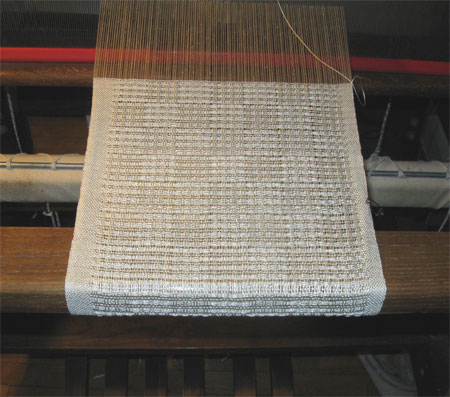
Even here, the design isn’t as pronounced as I might like. So I enhanced the next picture to show the lines clearly.
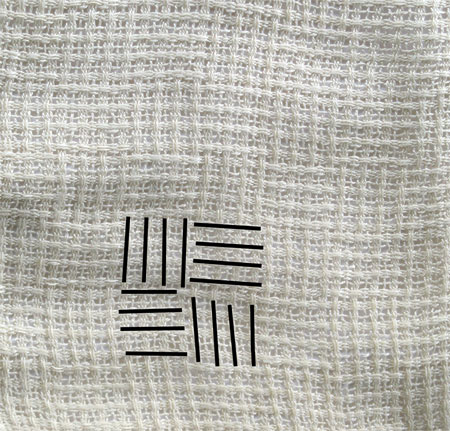
With the scarf wet finished & pressed, I think these silk scarves are elegant, even if the design is somewhat subtle.
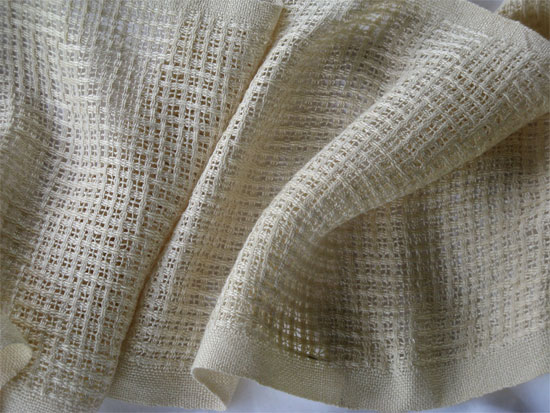
Interestingly, although my July show was really wonderful, I didn’t sell any of these silk scarves. Nor did I sell my ice green silk lace. You just never know what people will buy. Or at least I don’t.
I’m sure not complaining — I sold 6 shawls and 47 scarves at that show!!!! So now I’m weaving like mad again. Fortunately, I left myself almost seven weeks between the July & August shows, so I’m not making myself crazy.
For you weavers, here’s the draft of the checkerboard lace if you’re interested.
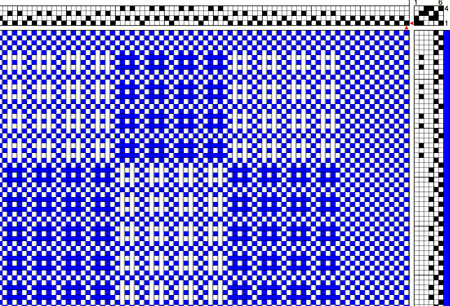
Like most weavers, I have quite a stash of yarns.
When I’m at a show (not very common for me) and I see yarn I like at a good price, I buy it. Then I come home and have to put it away, and sometimes forget about it. Months later I’m looking in one of my boxes for something, and get a pleasant surprise at finding a yarn I’d forgotten about, particularly when the color & fiber still make me smile.
That was the case when I found 2 cones of 10/2 cotton in a color I was calling buttercream. After the scarves were woven I had to change the name – the color was richer yellow than what I think of as buttercream. I opted for lemon chiffon. (The color is much more yellow than it appears in the photos. I’d still call the color in the photos buttercream.)
I decided to weave some huck lace scarves from it. I love weaving lace, both huck and a variety of Swedish laces. I like the way they look on the loom, the way they wet finish, and the way they please and amaze my customers when they see them hanging at a show.
I decided on an overall huck threading for this cotton, warped up my little counterbalance loom, and set to weaving. The first two scarves were woven in what I think of as typical huck. (I know I don’t use the correct terms for these lace weaves. Unfortunately, I didn’t know that when I started calling them by ‘my’ names, and somehow can’t seem to get the correct names planted in my brain.)
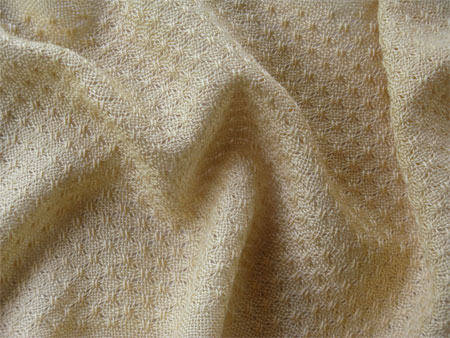
I’ve woven this pattern in 10/2, 8/2 and 5/2 cotton, cobweb weight cashmere-silk, 100% silk, and rayon. It never fails to please. I think the cottons work best, but it’s pretty much always a winner.
This time I opted to weave the third scarf in what I call ‘windowpane’ huck. Same threading & treadling, just a different tie up.
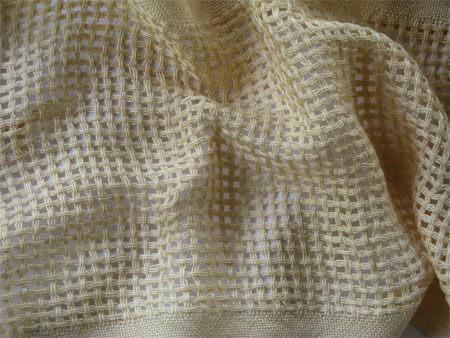
For some reason (I don’t know why) I haven’t used this option in a while. It does seem a bit more fragile, more prone to snagging a thread while wearing it, but it’s so lovely that people like it anyway.
The two scarves look so different, it really is magic that they’re so close in structure.
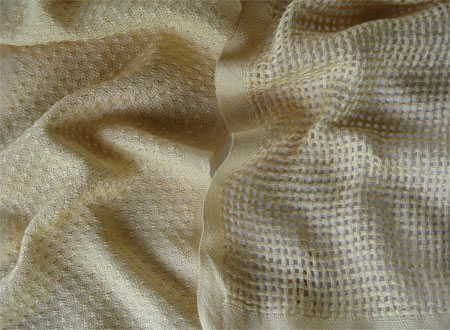
I took all three scarves to my show at Chautauqua Institute in July, and sold all three, bing, bang, boom. Shoulda bought more of that yarn when I saw it – buyer’s remorse in reverse.
Parting shot:
Mama Phoebe built her nest in the rafters underneath my porch. She’d just fed her babies and told them to be quiet since I was nearby.
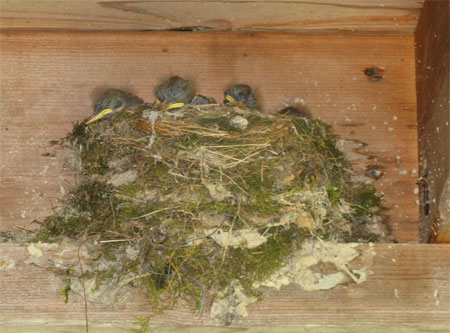
Laura Fry, a talented weaver who’s happy to share her expertise, just put out another publication — A Good Yarn: Cotton. Complete with actual weaving samples, 10 each in both pre- and post-finishing states, A Good Yarn is a wealth of information, predominantly information that isn’t available elsewhere. No one denies that. Some people, however are complaining about shipping costs. Laura lives in Canada, and shipping her new book, sans 3-ring binder, to the U.S. is $25. This photo shows my package, which arrived just yesterday.
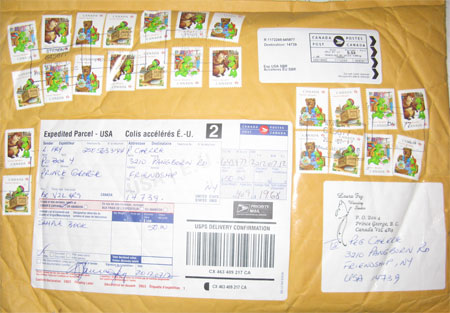
It is literally covered with stamps. Shipping costs what it costs. I know from personal experience that once a piece of mail crosses the Canadian border, the price increases dramatically. I can’t explain it, I just know it’s true.
——————
It started raining last night. It rained gently most of the night, amounting to about .4″ of rain by this morning. Lovely! A sweet, gentle rain that could soak right into the parched soil. Plus it lowered the temperature from our awful 90s to a cool high 60s. Then, all day long, the weather vacillated between a solid gray sky, a mist that was so light that it couldn’t be seen on the surface of my pond, and a rather hard rain. By evening, I’d received a truly wonderful 1.4″ 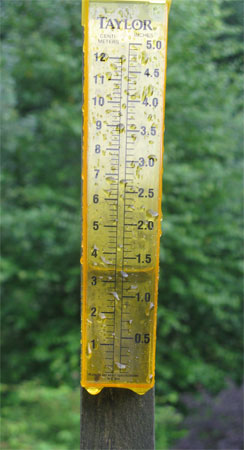
I was lucky enough to get another 1.4″ a few days ago Sunday – but it rained so hard and fast that much of it simply ran down the driveway after no rain at all for weeks on end. I’m thankful for the rain. Like most parts of the country, we’re in drought conditions, and neither of these rains were as widespread as they might have been.
——————
I recently completed some lovely (I think) pink Swedish lace scarves in rayon. I usually take the photos of my handwoven scarves when they’re laying flat on a sheet, showing how easily they curve and drape. Not this time.
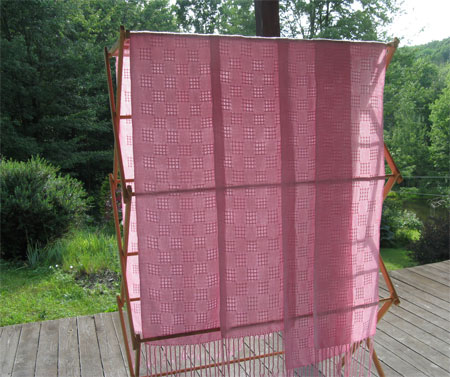
I’d washed the scarves and got them about 80% dry in the sun. Then I pressed them, and hung them back on the clothes rack to completely finish drying before I tagged them and put them away.
The sun hit them on the porch at a great angle, and I really liked the way they looked, so decided to take my pictures there.
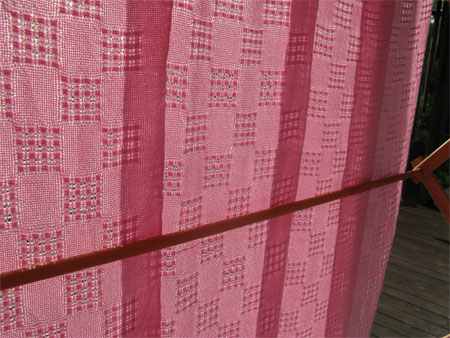
I hear what you’re thinking…”Peg has a VALET? I thought she lived ‘the simple life’.”
But it’s true. I have a valet. Built it myself. No, it’s not a robot that responds to my beck and call, it’s a warping valet.
What, you may ask, is a warping valet? It’s a tool that’s designed to make it easier to wind a warp on a loom when you’re working alone. Which I always am. I’ve never had the luxury of having someone help me warp. Some fibers, such as shiny rayon, go on nice and easy. Others, like unmercerized cotton or rayon chenille, require lots of teasing, coaxing, and fiddling to get on the loom. Although it’s sure not common, I have spent literally hours on some warps trying to get them onto the loom without problems. Once I have practiced with my valet, this should become easier and quicker. And since I weave to sell, anything that makes the tasks easier and quicker is much appreciated.
This is my first attempt at using my valet. Follow the bright green line to see the path of the yarn from the back of the loom, where it’s spread out in the raddle, to the chain in the bowl on the floor.
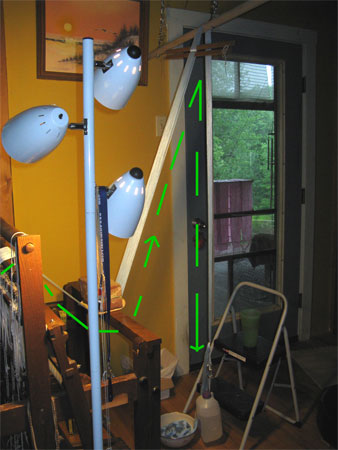
You’ll see I have it over my lower roller bars, under the breast beam, up and over the valet, weighted by about almost 1/2 gallon of water, and down into the bowl. The stool is only there because I’d just finished installing the chains and wanted to make sure I didn’t need to make more adjustments during the maiden voyage.
Here are a few other shots that will let you see my setup a bit better.
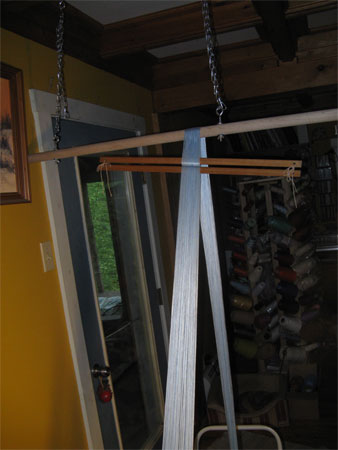
In this shot you can see the lease sticks up near the valet bar. As I wind the warp on the back beam, the water jug raises up and the lease sticks descend to near the breast beam.
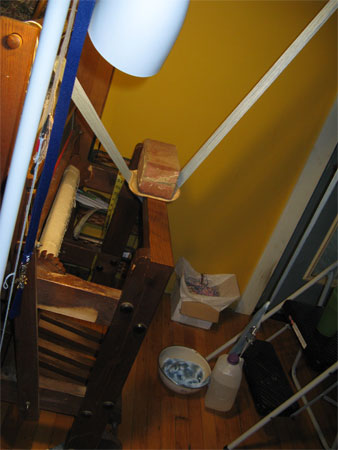
And’s here’s a shot of my temporary breast beam modification. This is a street brick (much heavier than a standard house brick) sitting on top of an old potholder so it doesn’t scratch the wood. Because my breast beam is quickly removed by a simple upward pull, it would not stand up to the tension of the water. I intend to make a more permanent modification to the loom and lose the brick, but I wanted to try this out first. For reasons that aren’t clear to me, I have a major hesitancy to make permanent modifications to either of my looms. So I want to make sure that this is the way the valet will work best for me before I break out the screw gun.
Although I’ve never met her, Laura Fry has taught me a great deal about weaving. She taught me how to speed up my weaving and retain great selvedges. She taught me the importance of the height of my stool (hips higher than knees, elbows at just above the breast beam). She taught me how to hold my shuttle correctly. And now she’s teaching me how to build & use a warping valet. She’ll be happy to teach you, too! Watch her youtube videos, buy her weaving CD, DVD and book, and by all means, read her blog. Laura’s a weaver who’s eager to share her talents with others.
On my first attempt, I must admit that it wasn’t totally comfortable for me. No surprise there – it’s a new process. My lease sticks kept going cockeyed, but mostly, it was a completely foreign experience to wind on that back beam under tension. I’ve never done it. I was concerned about the pressure it put on my little handmade loom. Then I realized that the same amount of pressure is applied the entire time that I’m weaving. Still, it felt very odd, wrong.
Once the warp was wound and the heddles and reed threaded, I could see a real benefit to the tension while warping. Tying onto the front apron rod has long been my least favorite part of weaving. I find it not only time consuming, but a place where I can really mess things up. If I don’t get the tension on all those threads right, I’m in a weaving mess. I can tell you it was rather a breeze with the tension-wound warp.
Granted, I did my first run with rayon, which is easy to warp anyway, but still, I’m counting it as a success. With practice and my own modifications for my specific setup, I’m confident I’ll like this valet.
Thanks again, Laura!
Trust me, I know it’s important to be consistent with my blogging. Important to my readers, important to my business, important to my structured-ness.
I try to be. I really do. Then I get so busy I barely have time to go to the bathroom, much less blog. And if that’s not bad enough, my sweet kids got me a Kindle for my birthday. Before I’d figured out how to download library books, I’d downloaded two word games when I registered it. Now there are real time thieves!
Like most people, I pop around the web. Most of my popping is related to weaving — looking for ‘the ideal’ loom, checking out my favorite weaving bloggers and sometimes looking at their favorite bloggers, etc. In doing so recently I stumbled on an idea that I thought I’d turn into a product in my inventory – on a small, trial basis – and see how my customers responded.
Introducing the neck cuff
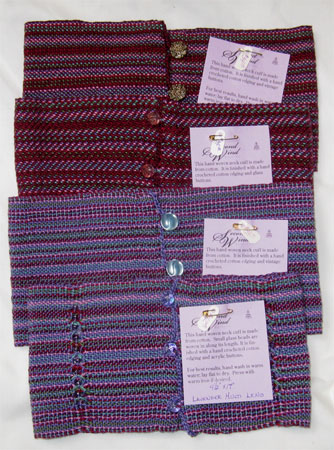
These are 5/2 cotton & all have vintage buttons. I thought this new product was a great time to try a warping technique I’d read about but not tried – using multiple color threads without a warping paddle or other method to attempt to keep them in order. Instead, simply wind them as a group, then take them as they come rather randomly off the lease sticks.
I liked the ease of winding the warp, and the finished look, but I would not recommend this method for a warp any longer than a few yards. Those unorganized threads do a great amount of twisting themselves into tight, little bundles that require often tedious hand work to untwist in order to advance the warp. Maybe this would work better if I was a front-to-back warper and had spread the threads out in the reed as I warped, but I’m a back-to-front warper.
Anyway, I liked the way I could use multiple weft colors to achieve different looks. These two have a cranberry weft. Interesting how different a tabby/plain weave and a simple twill look, isn’t it?
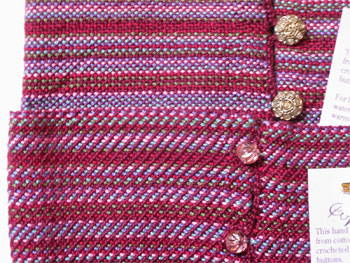
I did leno with an E bead on one of the the cuffs with a lavender weft.
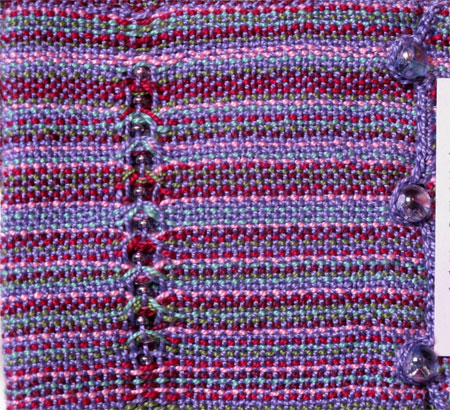
I for sure liked the final result of that beading, and for sure disliked the process of getting it beaded. Putting lots of beads on the yarn after I had it wound it on the shuttle, and then constantly pushing those beads back out of my way as I wove the areas of plain weave was a slow, tedious process. I only wove with beads one other time, inserting them rather randomly throughout the plain-weave scarf. I both loved the outcome & hated the process that time, too. This one used so many fewer beads and was so small, I thought it’d be fine, perhaps even fun. HAH!
I closed out the set with a 10/2 cotton in a sweet lemon chiffon color, with leno (no beads) along it’s length.
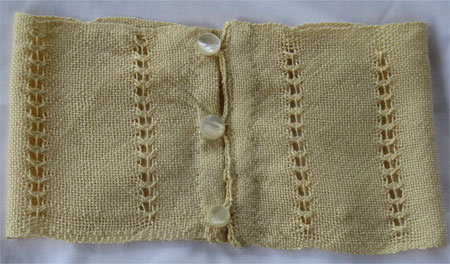
I’ve had the cuffs at two shows now, and have sold both lavenders. I don’t know how many more I’ll make, but a few, anyway. I’ll do some more experimenting with colors, sizes, & buttons or other closures.
Parting shot…”Quit blogging and let’s go for a walk already!”

|
|





















